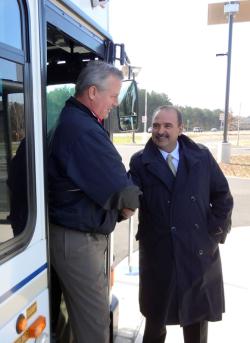Parking Lot to Nowhere

Photo Credit: Blake Aued
Can a parking lot have an existential crisis?
If it were a sentient being—like a introverted philosophy major, for example—the new park-and-ride lot on Oconee Street at the Loop would surely feel unwanted, unloved and lacking any purpose in life. It threw a party, and nobody came.
It's only been open for three weeks but, so far, the $2.4 million lot is a boondoggle to rival the Alaskan "Bridge to Nowhere" that Sen. John McCain once held up as the poster child for federal pork-barrel spending. Spot checks found just a couple of cars, sometimes even none, parked in the 223-space lot during office hours on weekdays.
Still, Athens-Clarke County officials are optimistic that it will catch on. "It has not taken off yet," Athens Transit Director Butch McDuffie says. "I'm hoping as word gets out, it'll catch on. It'll take a while."
No one really wanted the lot to begin with. In 2003, when Congress was working on a massive transportation bill, then-Rep. Max Burns asked ACC officials for projects they'd like funded. The top priority locally was a rails-to-trails project. Instead, Burns inexplicably got Athens funding for a park-and-ride lot, which was far down the list. (His successor, John Barrow, later secured funding for the rail-trail.)
When the federal bureaucracy finally released the grant money in 2006, local officials first looked to the bypass interchange at College Station Road. Several county commissioners and Eastside residents objected to that location, though, because they thought it was too close to the University of Georgia, and it would increase congestion and make a gateway into town uglier. The commission later considered sites at property owned by First Assembly of God, College Station Road Shopping Center and Willowood Shopping Center, but the grant was for construction only; it didn't cover land acquisition. That left the Oconee Street cloverleaf, which the state Department of Transportation was willing to let ACC have for free.
The lot was so unpopular that commissioners briefly considered returning the federal grant. "Rather than give everybody this amount of heartburn, just give the money back and move on," Commissioner Harry Sims said in 2007.
But the lure of free money won out, and commissioners also reasoned that a new lot for UGA commuters would cut down on students and staff parking in residential neighborhoods. They voted to approve the Oconee Street location in 2008, and work finally started last spring. It officially opened Jan. 24.

Planning Director Brad Griffin (left) is greeted by Athens Transit Director Butch McDuffie at a ribbon-cutting ceremony for the park-and-ride lot last month.
At the ribbon-cutting ceremony, Mayor Nancy Denson said the lot could improve traffic at one of the most backed-up rush-hour intersections in the city by taking cars off the road. "We hope it's going to relieve a lot of the congestion coming down here on Oak Street," Denson said. The lot has other green features as well, such as porous pavement, rain gardens and solar-powered streetlights.
And McDuffie predicted that it would improve the parking situation downtown and on campus by giving commuters the option to park short of their destination, then take a bus the rest of the way. "We're hoping this lot, the 230 spaces here, will hopefully free up some spots downtown and in the campus area for other cars," he said.
It hasn't happened yet. No more than four cars have been parked in the lot at any given time, McDuffie says. But it did see a 50 percent spike in use. "We went from two to three vehicles," he jokes.
On a recent afternoon, the sole car in the lot belonged to Michelle Green, who works in accounts payable at UGA. She says she's saving $40 a month by parking in the free lot and scanning her UGA card to board Athens Transit without paying. (UGA reimburses the county.) "It's great to be able to park here, get straight on the bus and go to work," Green says.
It's folks like Green who are paying to park downtown or at UGA who will eventually fill the lot, McDuffie says. But right now, most of those commuters are locked into parking contracts. "If you're already paying for a parking pass, you're not going to give it up to ride the bus," he says. This fall, though, when the next school year starts, UGA students and employees will begin to use it, he thinks.
A key to the lot's success is a new shuttle that runs every 20 minutes from 7–9 a.m. and 3:30-5:30 p.m. on weekdays, stopping at Brooks Hall and the Arch. Three regular hourly lines serve the lot from 7 a.m.–10 p.m. every day but Sunday. The shuttle will cost about $70,000 a year to run, at least a third of which McDuffie wants to recapture at the fare box. "In the big picture, that's not much," he says.
But to keep the shuttle running, people have to use it. "This is a trial service right now," McDuffie says. "If folks aren't using it, say, six months or a year from now, we'll re-evaluate whether we need to be spending that money."
ACC Commissioner Allison Wright is calling for better signage to direct people into the lot. Drivers coming from the Eastside or Oglethorpe County have to pass the lot, then make a U-turn and come back to enter it. If they're leaving and want to go downtown, they have to turn right out of the lot and also make a U-turn. But U-turns are illegal at some intersections. "Getting that straight so people can make a U-turn and not get a ticket is going to help get people in there," Wright says.
The lot includes a driveway leading to the Loop off-ramp for buses only, allowing them to turn left at the light to head downtown, and McDuffie says he's trying to convince GDOT to let cars use it, as well. GDOT is also building a full cloverleaf at the interchange, which should help improve traffic flow, too.
But for now, the lot sits empty, alone and forlorn. "It's going to take time for it to catch on," McDuffie says.












comments